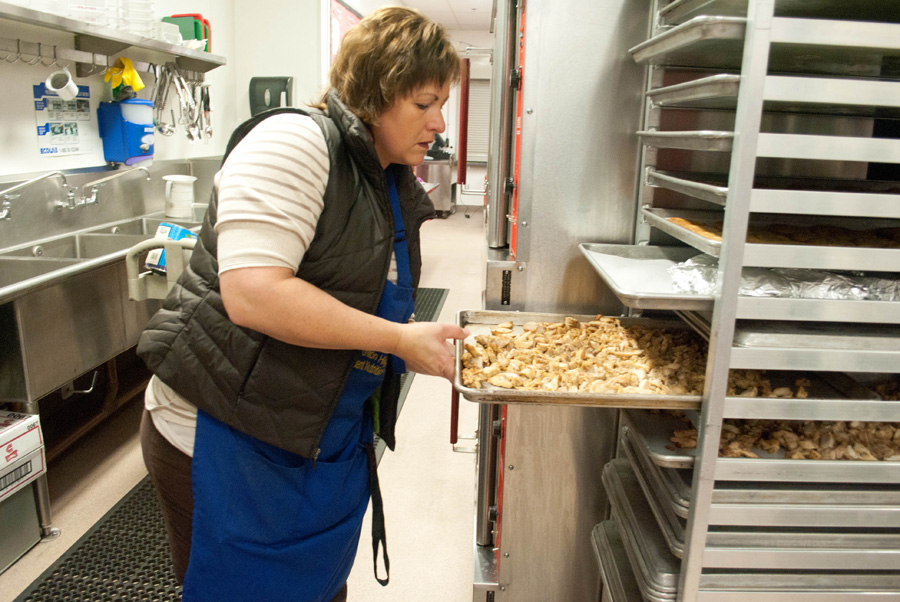

School lunches are expected to be available for anyone who needs lunch. However, perhaps school lunches aren’t entirely student-friendly. The State of California has certain requirements that school lunches must meet in order for them to be sold at schools, but none of them require options for students with different diets, nor do they require taste tests to ensure that the majority of students find the school lunches tasty.
Aragon’s population is made up of a very diverse student body, and these differences include eating habits, as evidenced by junior and vegetarian Hayley Wilcox. “I’ve been vegetarian for eight and a half years. I don’t really buy lunch from our school; it doesn’t really look appealing. But from what I see, there aren’t very many options. Sometimes my friends get bagels for brunch, and I’ll eat those or the fruit salads that they have for lunch. I’ll have some of that, but, I don’t exactly have many choices from there.”
The State of California has made several reforms to improve the food offered to students in schools. For example, in 2007, Senate Bill 12 set criteria for the amount of fats, sugars, and calories a food item can have in order for it to be sold in a school. Similarly, Senate Bill 965 set similar standards for beverages that can be sold in schools.
Other bills have also been passed to make sure students from low-income families are able to afford school lunches. Only recently has the state government introduced a bill—ACR 16—that expands options for kids with a vegetarian diet. This bill was introduced in Nov. of 2011, but has yet to pass. If it were to pass, schools would be required to offer choices for all kinds of vegetarians; those who eat animal products, such as dairy, and those who don’t eat any animal products whatsoever.
Junior Paige San Felipe, who was vegan for a short while, comments, “I don’t think there are many choices at all for vegan or gluten free, except like fruit. Vegetarians have more options, which aren’t healthy, though.”
However, for the students with diets that aren’t quite as strict, opinions on school lunches varies widely. Senior Ian Roque comments, “Yeah, I like [school lunches]. I think [vegetarians] have enough choices, but definitely not as many as the omnivores.”
Senior Jazmin Sacchi shares a much different opinion, “I personally don’t like [school lunches]. I think they’re too junk-foody, and they’re too expensive. If they were at a cheaper price, I’d buy some of the stuff they sell, but some of their stuff is too unhealthy, so I try to bring my own lunch.”
As for the students with different diets, Sacchi comments, “I think vegetarians might [have choices], but vegans maybe not, because there’s a lot of cheese and stuff. There’s not enough fruit and vegetables. I mean they have, like, maybe one salad. So, there should be more options.”
However, there is a limit to how much schools can spend on school lunches. According to the California Department of Education, $2,134,794,000 is available for making and distributing school lunches. This could answer the question, regarding why school lunches aren’t simply better.
When asked if she would buy better quality lunches, junior Nicole Horita says, “No, it’s cheaper to make your own lunch.”
However, the ladies in charge of school lunch lend an alternative perspective.
Aragon Nutrition Services Assistant Vicki Ottaboni explains, “The state is making us make the meals we serve. Everything that we get is only what the government will allow us to have. There’s nothing we can do.”
“It has nothing to do with the budget,” explains Ottaboni. “There’s things that we are not allowed to have. We’re not allowed to have oils. There’s a lot of things we aren’t allowed and a lot of that stuff is what makes food taste good. Real butter makes food taste good, but we aren’t allowed to have real butter.”
As for stricter diets, Ottaboni comments, “We always have fruit salad, which is a vegetarian option… we always have peanut butter sandwiches and cheese pizza and nachos. That’s a lot of options considering we only have a handful of vegetarian kids.”
However, there could be more food choices, should the students ask. Ottaboni adds, “If somebody has a problem and would like to see something else, come suggest it, and if we can get something that can help them through, we’re here for [students], but we don’t know if they don’t tell us.”



